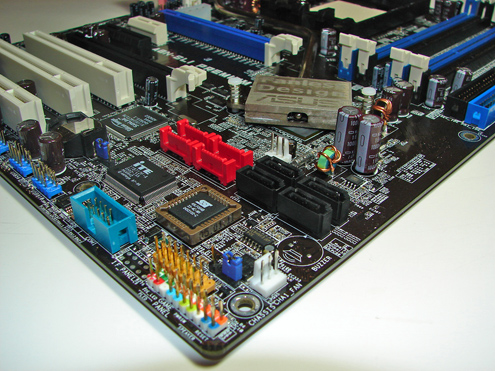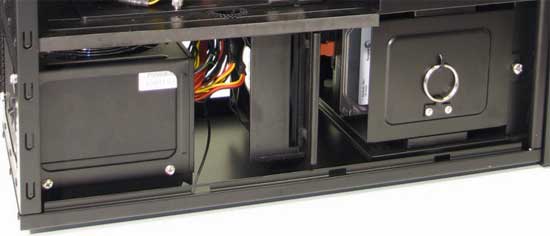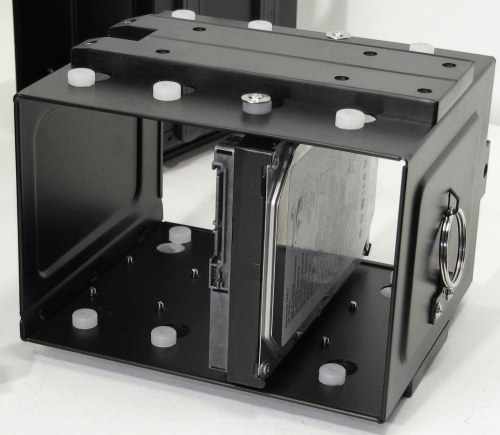A Lesson in User Failure: Investigating the Serial ATA Connector
by Ryan Smith on January 18, 2008 12:00 AM EST- Posted in
- Storage
SATA Anatomy, Failure Anatomy
It’s best to start first with a quick history lesson on the SATA design, as it hasn’t been static through the years. It has gone through some important revisions - some visible and some not – that have shaped the SATA connector in to what we see today. We’d also like to thank Knut Grimsrud, chairman of the SATA International Organization and Intel Fellow in their Technology & Manufacturing group for helping us out with this article and answering some of our questions.
First and foremost, the SATA-IO identified issues early on with the design of the SATA connector, and has revised it several times. This is most obvious in the move from the SATA 1 motherboard connector to the SATA 2 motherboard connector, where the SATA 1 motherboard connector was far more exposed than the SATA 2 connector. This switchover was particularly evident on boards using both native and external SATA controllers, where one would be SATA 2 compliant and the other SATA 1, requiring the different connectors.

The SATA 2 motherboard connector added shrouding around the connector, which significantly improved the durability of the connector as the shrouding prevented cables from easily bending the wafer part of the connector. Unfortunately this kind of shrouding couldn’t be added to SATA devices, because the standard was designed for use in small devices that don’t have clearance to fit a full shroud. This results in the modern half-shroud design for devices, where the top-half of the connector is shrouded by the device but not the bottom half.
The other significant changes in the standard since its inception have been latching and chamfering. Most SATA devices now have recesses in their top side shroud that allow barbs on SATA cables to latch in to in order to provide downward stability since the underside is the unshrouded side. Chamfering has been added to the square edges of the tongue, and while not a visibly dramatic change, we’ve been told this is one of the primary improvements in strengthening the SATA connector.
Yet in spite of these changes we’ve still managed to do something wrong and break the connector on our hard drive. For the reason why, we’ll start with case designs and cable designs.
Part of our problem can be attributed to the amount of space we have to work in with the case involved in this investigation, the Antec P182. The P182, like many other cases, doesn’t leave a lot of space behind the primary hard drive bay. For most cases this is because there are motherboard components and cards in the way, while with the P182 it’s a matter of a 120mm fan being located behind the hard drive bay, which helps pull air through the lower chamber. Either way, with this specific case, we measure that we have about 2” between the rear end of a hard drive and the fan, which is very little space to work in.

We then come to the cable, in this case it was a bog-standard cable that came with one of the products we’ve used over the years. As we mentioned earlier, SATA cables aren’t quite as flexible as PATA cables when it comes to longitudinal bending, and while we can technically bend a cable completely over at any location, this isn’t great because it causes the cable to pull back in to a more relaxed position. From the tip of the connector, the cable we measured needs about 2.5” of space to bend comfortably.

With the amount of clearance we have being less than the amount of space to need to ideally bend the cable, it becomes obvious that this will quickly become tricky. We need to bend the cable at a sharper angle so that it stays well clear of the fan, which means it’s going to be exerting some force on our hard drive, a generally acceptable but not ideal situation.
And then finally there is the layout of the P182’s hard drive bay. The P182 requires the hard drives to be installed in to the cage at an angle, such that they are on their sides with the bottom pointing towards the bottom of the case, which you can see here. Keep in mind the fact that the top hard drive is on the opposite side of the case from where the motherboard is.

In this combination, we have the anatomy of our failure. Our cable is putting force on the SATA data connector towards the bottom side, which as we covered earlier is the weaker direction to go because it’s not shrouded like the top side is. Furthermore we’re using a SATA-1 style cable without a latch, which means we don’t have said latch to reinforce the connection. It turns out that this is enough force to break the SATA data connector on our hard drive, and when the drive cage was being secured one day the connector broke.











62 Comments
View All Comments
superkdogg - Tuesday, January 22, 2008 - link
I've broken off a couple SATA tabs on the drive side myself. It's exactly as you described in that they work fine, they just don't suffer a user's abuse like a PATA would.Luckily, it's almost always going to be fixable. You guys 'Macgyvered' it with tape, my solution was to treat the tab as part of the connector cable as well, only I used glue.
I glued the tab first to the cable, then glued the other end back to the drive where it broke off from. It's not elegant, but it's as durable as it was before and there's no chance I'll lose the cable that connects that particular drive!
spellbinder1966 - Monday, January 21, 2008 - link
Yeah, I had the same concerns when I built two of my P180b rigs.I placed four disks at the bottom (coz I use the upper HD chamber to cool the video cards). I had to carefully bend them (it was so tedious).
I think the 180° TO 90° SATA cables would help a lot (http://www.cablestogo.com/product.asp?cat%5Fid=927...">http://www.cablestogo.com/product.asp?cat%5Fid=927... but I believe the 180° to 90°-SIDE SATA cables will be much more appropriate. (http://www.cablestogo.com/product.asp?cat%5Fid=927...">http://www.cablestogo.com/product.asp?cat%5Fid=927...
daddyo323 - Monday, January 21, 2008 - link
As a case in point (no pun intended), I see many posts here from people who had the same problem with the Antec 180. IMO, case makers spend too much time focusing on the CPU/graphics cooling in their case, and not enough time on the welfare of the drives... Most drive bays look like an afterthought, with plastic parts and so-so ventilation... When you consider that the data you store can easily be worth many times the entire computer, and is NOT replaceable like a hardware part, the drive bays should be the most engineered part of a case... Yes, backup solutions are necessary, but case makers need to give the drive bays more love...johnsonx - Monday, January 21, 2008 - link
Reading all the comments of those who have done this same thing, all I can say is:You all suck, I've never broken so much as one SATA connector. Gently little ones, gently!
Ok, so I'm a cocky little s.o.b. this morning, haha!
strikeback03 - Monday, January 21, 2008 - link
For the most part I have just used the red SATA cables that come with most motherboards, optical drives, etc; and I assumed the lack of flexibility was a result of the design. Then I picked up a WD drive on Black Friday for a system at work, and the included cable was MUCH more flexible than the average ones I have used. Is there a reason these are not more widespread? Are they more expensive? Is there a reason the cable can't be round like FireWire to allow equal flexibility in all directions?Wolfie - Monday, January 21, 2008 - link
Now Ryan, you know breaking things should just be left by playing UT but I guess we can forgive you this time. :)This is always good to know since I just obtained a setup that untilizes these types of connectors. And not to mention, UPS is not nice on equipment. Hence the reason why I had so many issues getting this box up and running. I thought these types of connectors where chincy at best. Maybe a different type of connector all together? Hrm, maybe I found my money maker...
lbreevesii - Sunday, January 20, 2008 - link
I had this happen installing(read: jerry rigging) a 500gb seagate into my GX260 slimline home server. I managed to fix it by super gluing the wafer back into place.MadBoris - Sunday, January 20, 2008 - link
Funny, I have been cursing SATA connections for the past few days working on a couple systems.I am seriously surprised that the industry somehow thought this was a good connection mechanism. Sometimes due to video cards and other add-in's and the location of the drive cage coupled with the onboard controller, passing a sata cable to the drive becomes very difficult and even an unreliable fit. The cable only wants to bend in one axis. Yesterday looking at my machine one of my drive letters disappeared, after a check in eventvwr the drive apparently disconnected itself while I was sleeping (probably temperature fluctuations), I found it was a flaky SATA connection.
SATA connections seem very flimsy to me in general, having anything but a straight shot, or a bend in only one axis on the cable, to the slot makes them appear very unreliable and unsure at best.
Whoever thought this was a good connecting mechanism was really foolish, if I didn't have several bad experiences w/ sata I couldn't really say that. I'll take IDE over the unsure SATA anyday. I may have bent a pin in the last decade but never a critical issue. Some locking mechanism, and/or more flexible cable, is a no-brainer. The stupidity of some smart people can be surpising at times as with the sata cable and connection mechanism.
MastahYodah - Sunday, January 20, 2008 - link
The same thing happened to me a couple of days ago. I was able to put the connector back and hoped for the best. Luckily, the pc still recognized the drive; however I'm afraid to move or do anything inside the pc in fear of disconnecting it.hlee - Sunday, January 20, 2008 - link
i tracked several "unreliable computer" problems to bad sata cables ... the computers would just reboot or crash whithout reason once in a while .. i found a broken plastic part like yours in one case but 4 others were not broken but just bellied out .. i figure that plastic bulge problem reduces contact pressure thus reliability .. my configuration has no undue stress on the cable and no excessive heat .. i saw 5 failures in less than a year (even different cable/drive manufacturers).. some systems would only fail once a week or even a month. just rebooting would fix them for another period .. after changing the cables to the new ones with the metal clips i had no more failures. that cured a lot of frustrating problems .. i reported this to a large local computer store/repair center .. but they didnt believe what i was telling them .. however they did admit that they had seen several early sata drive failures .. they just replaced the drives (and cables) often at customer expense .. i think the plastic lip on the sata cable is just too thin to handle constant contact force. it needs stronger plastic or a reinforcment like the metal clip to maintain contact force over life .. now whenever i see a "bad" or intermittant sata drive i just change the cable and that often fixes the problem. the store still sells the old type cables that dont have the metal tab .. although the improved ones are also in stock .. if you dont know about the problem then you might be buying trouble a few months down the road. i heard that one big computer manufacturer was sending new (but not improved) sata cables to customers that had intermittant conditions. the new cables would work for a year or so and fail again ..